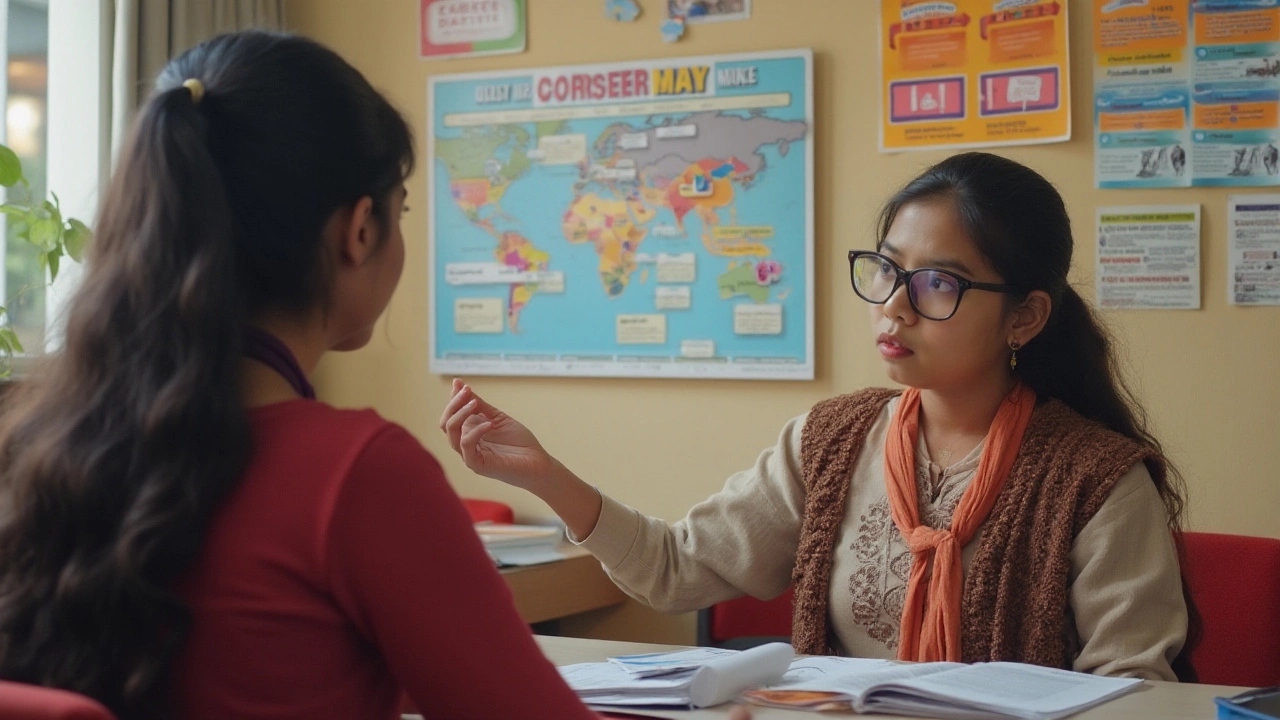
Education in India follows a structured path where students typically advance from school to college by completing their 12th grade. However, the road is not singularly defined, as diploma courses offer parallel tracks that beg the question of equivalency with traditional schooling.
This discussion delves into the reality of diplomas and their standing beside the 12th-grade mark. Many students, especially those leaning towards practical knowledge, explore diplomas as a valuable alternative. But are they really interchangeable? Let's explore what makes them similar, where they diverge, and the implications for students choosing this route in India's diverse education landscape.
- Understanding Diploma Courses in India
- Equivalency with the 12th Grade
- Opportunities & Limitations of Diplomas
- Guidance for Aspiring Students
Understanding Diploma Courses in India
In India, diploma courses serve as a pivotal alternative to the traditional path of higher secondary education. These courses typically focus on a more hands-on approach, blending theoretical understanding with practical application. While they differ in structure and outcome compared to the 12th-grade format, they hold immense value for students who are inclined towards specialized fields. Generally spanning two to three years, these courses are offered by polytechnic institutions. Students from various backgrounds find these options attractive, mainly due to their targeted curriculum and the diverse fields available—from engineering and technology to hospitality management and art. This specialization often leads to a more immediate application in the workforce, offering students a potentially faster route to employment.
Diploma courses are designed to equip students with specific skills that aid in practical job roles, making them uniquely appealing. They cater to the demands of many segments in the industry. For instance, diplomas in engineering fields, such as electrical or civil, are quite popular due to the robust demand in infrastructure development in India. This demand creates opportunities for immediate employment after the course, an enticing prospect for students looking to enter the workforce without prolonged academic commitments. These courses are not only practical but also evolving, ensuring they stay relevant in an ever-changing job market.
One of the misconceptions about these courses is that they are inferior to the traditional academic routes. On the contrary, the design of diploma courses focuses on imparting industry-ready skills. These courses often include on-the-job training and internships, providing real-world experience to the students. According to a study by the National Skills Development Corporation, students with diploma certifications are often absorbed faster into the job market than their peers with only higher education degrees.
"The advantage of diploma courses lies in their curriculum that is aligned with industry needs," stated an educational reform consultant in a recent conference on vocational training.Such endorsements emphasize the importance of adapting educational paths to fit diverse learner needs.
In adapting to students' varied learning requirements, the Indian education system ensures that diploma courses fulfill a vital role. They are not a mere substitute for the 12th-grade but a complementary pathway that should be chosen based on the student's preferences and career goals. Students, particularly those who may not wish to pursue mainstream academics, find these courses offer a closer fit to their aspirations, allowing them to dig deeper into their interests while contributing to society meaningfully. Encouragingly, the availability of diplomas in numerous sectors opens up worlds of opportunity for young learners who wish to carve their niche without the traditional shackles of mainstream schooling. This diversity ensures the resilient growth of these courses in India's educational landscape.

Equivalency with the 12th Grade
In the bustling and varied landscape of the Indian education system, a crucial question emerges for many students: is a diploma course truly equivalent to the 12th grade? This question not only dictates future academic and career choices but also influences how vocational training is perceived in society. A diploma course in India typically lasts for three years and is available after Grade 10, providing practical and hands-on training which is often appealing to those driven by application-oriented learning. The curricula of diploma courses are designed to match specific industry needs, providing a bridge directly into the workforce or further advanced technical studies.
The question of equivalency is a bit more nuanced than it appears on the surface. Official recognition and acceptance vary widely among higher education institutions. A recognized diploma may allow entry into a second year of a bachelor's degree in the same field, but not across unrelated fields. Therefore, for a student eyeing a specific university course post-diploma, confirming the institution’s acceptance policy is essential. The Indian government and regulatory bodies such as the All India Council for Technical Education (AICTE) have established guidelines on equivalency, sometimes accepting diploma holders as 12th-grade equivalents, especially in engineering contexts. However, permissions and equivalencies can vary depending on the course and location.
It's important to note that some universities expect additional bridge courses to fill the gap that a diploma might not cover compared to traditional schooling. On the other hand, certain sectors offer almost seamless entry for diploma holders due to the demand for practical skills over theoretical knowledge. As renowned education expert, Professor Anil Swarup once mentioned,
"The recognition of diplomas paves a way for diverse skills that are often neglected in conventional educational structures". His insights emphasize how, at times, the industry values the skills imparted by diploma courses more than rote academic skills.
Consideration of equivalency involves weighing the value of industry readiness provided by diploma courses against the conceptual depth often attributed to 12th-grade education. It's a complementary journey, where academic aspiration meets vocational proficiency. In recent years, trends have shown an increase in hybrid courses where elements of both streams are intermingled to cater to changing industry demands. The choice, ultimately, depends on the student’s clarity of purpose and the path they see for themselves in the bustling matrix of India's educational and vocational landscape.

Opportunities & Limitations of Diplomas
Diplomas play an intriguing role in the landscape of Indian education, offering a distinct path that diverges significantly from the traditional 12th-grade route. One of the enticing opportunities that diplomas provide is the early onset of specialization. While students in the standard 12th-grade completion may engage in broader academic subjects, diploma students immerse themselves deeply into vocationally relevant material sooner. This can be an attractive choice for students who have a clear interest in fields like industrial training, design, or technology. Enrolling in such programs often allows students to develop industry-specific skills and knowledge, which can shorten their journey to starting a career.
However, despite these opportunities, diplomas also come with their set of limitations. A crucial downside is their varying acceptability when it comes to higher education. Not all universities regard diploma credentials on par with the completion of the 12th-grade exams. This potential roadblock means that a student aiming for degrees in traditional academic fields may need to undertake extra qualifications to gain admission, which could be a detour rather than a shortcut. As such, students must be vigilant about their long-term educational goals and align their choices accordingly.
The job market implications of a diploma can similarly be a mixed bag. In certain industries, such as engineering and technology, a diploma can sometimes accelerate entry-level employment opportunities. Surveys indicate that some diploma holders can secure jobs swiftly in growing sectors, diving into hands-on roles that benefit their career trajectory. However, the perception is not uniform across all fields; some competitive markets still prefer traditional degrees or may offer reduced pay scales compared to their degree-holding peers. This discrepancy necessitates careful consideration from students aiming for specific sectors.
Additionally, there's an emotional and social dimension to consider. While vocational streams through a diploma can foster a practical approach to learning, students sometimes report a sense of missing out on the typical high school experience. The camaraderie, the broader curriculum enjoyments, and the extracurricular activities often associated with the 12th-grade journey are less emphasized in diploma courses. Yet, this does not devalue the worth of diploma programs but highlights the contrasting experiences between the two educational paths.
Reflecting on these dynamics, one might remember the words of Ratan Tata, who once spoke of innovation in education. He said,
"Upskilling oneself in niche areas often carves a path to a future job market that values skill over tradition."These words resonate with the ethos of diploma courses, emphasizing specific skill sets poised for industry's practical needs while recognizing where they fall short in educational comprehensiveness. In the end, choosing a diploma or the conventional 12th-grade path boils down to evaluating personal interests, career aspirations, and the desired pace of education. Being armed with the right information, students can navigate this path with confidence and clarity.
| Criteria | Diploma Courses | 12th Grade Completion |
|---|---|---|
| Focus | Specialized, Vocational | General, Academic |
| Acceptance in Higher Education | Varies | Widely Accepted |
| Entry into Workforce | Fast for Relevant Fields | Often Requires Further Study |

Guidance for Aspiring Students
For students contemplating whether a diploma is the right fit compared to the traditional 12th grade, understanding personal goals is key. It's crucial to assess one's interests and career aspirations, as these can heavily influence the decision. Diplomas offer a more hands-on, practical approach, which many students find appealing, especially those who wish to delve into fields like engineering, design, or vocational trades. On the flip side, traditional 12th-grade education might suit those aiming for conventional higher education pathways.
Navigating this decision should involve thorough research. Students should explore the kinds of diploma courses available, their duration, and the curriculum content. In India, diploma courses can vary widely in subject matter – from technical and engineering diplomas to ones focused on healthcare or management. It's essential to understand what each course entails to ensure alignment with personal and professional objectives. Engaging with academic counselors can offer additional insights and clarify doubts.
Furthermore, understanding the education pathways and the long-term opportunities each option provides is vital. Speak with college advisors, attend open days at institutions offering diploma programs, and seek feedback from current students or alumni. These dialogues can offer insider perspectives often overlooked. By delving into these interactions, students can gain insights into the real demands of these programs and whether they're equipped to meet them. Consider programs that not only meet educational goals but also provide strong networks and career placement opportunities.
As Abraham Lincoln once said, "The best way to predict your future is to create it." This adage rings especially true for students on the brink of educational decisions that could shape their futures.
For those opting for a diploma, some institutions may demand entrance exams or require students to meet specific eligibility criteria. It's crucial to prepare adequately for these requirements. Resources and study materials are often available online or through learning centers, and these can offer structured paths to prepare and excel in these assessments. This preparatory phase is critical as it often determines eligibility and placement within competitive programs.
The decision between a diploma and traditional schooling does not have to be made in isolation. Engaging with peers, mentors, and family members for support and advice can provide the emotional backing to navigate this significant choice. Parents, though often proponents of traditional routes due to their experiences, should consider the evolving educational landscape and the growing acceptance of diplomas. This broad perspective can support a more informed and balanced decision-making process.
